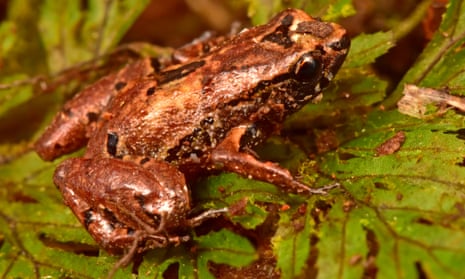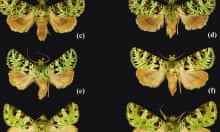An “ecological Swat team” has discovered 20 previously unknown species in the misty cloud forests and cascading waterfalls that flank Bolivia’s Zongo valley.
Among the animals found were a minuscule 10mm-long frog, a pit viper, two metalmark butterflies and an adder’s-mouth orchid. The pristine forests are just 30 miles (48km) from the capital, La Paz, but the expedition also rediscovered the devil-eyed frog, seen just once before, and a satyr butterfly not seen for nearly a century. Alongside these were threatened species including the spectacled bear and the channel-billed toucan.
The high, steep-sided peaks of the Andes harbour enormous biodiversity because movement between them is difficult for wildlife and results in isolated hotspots of evolution that are known as “sky islands”.
The scientists spent two weeks hiking up and down the 2,000-metre slopes and, while expecting to find some new insects, were surprised by what they encountered. “We certainly did not expect to find new vertebrates, like the two snakes and the frog, so that was very exciting,” said Trond Larsen, of Conservation International, who co-led the expedition with Claudia Cortez, the head of conservation for the municipal government of La Paz.

“What’s so amazing is that you could hear the distinctive call of the little frog throughout the forest, but you get close and they stop calling,” Trond said. “Trying to spot it when it’s not making a sound and is hidden in the moss was a tremendous task.”
The team rediscovered the devil-eyed frog that had only been seen once, 20 years previously, by Steffen Reichle, a Bolivia-based scientist who was also on the new expedition. “That was really exciting – it was just assumed it must have gone extinct, but we actually found it to be relatively common,” Larsen said.
The expedition was part of Conservation International’s Rapid Assessment Program, which Trond describes as an “ecological Swat team” that responds when information on a poorly known area is urgently needed.
In the Zongo valley, the assessment is underpinning a new conservation area that will protect not only wildlife but also the clean water, construction materials and forest foods that local people rely on. The ecosystem also regulates the flow of water to the small dams in the valley that help power Bolivia’s capital. The protected mountain slopes will furthermore provide vital refuges for species moving uphill to escape the rising heat brought by the climate crisis.

The 17-strong team of scientists hiked into their study area over a long, high suspension bridge that spans the Zongo River. As well as the highly venomous pit viper, they found another new snake which had the red, yellow and green colours of the Bolivian flag.
The flowers of the new adder’s-mouth orchid appear to mimic an insect and may serve to fool unwitting pollinators, while a new cup orchid displayed striking purple and yellow flowers.
A bamboo species found by the team was new to science but already well known by indigenous communities who use it to make musical instruments called sikus, or panpipes. Another plant, in the arrowroot family and which closes its leaves at night, similar to hands in prayer, was rediscovered after 125 years.
“This truly beautiful and diverse landscape has become a safe haven for amphibians, reptiles, butterflies, and plants that haven’t been found anywhere else on earth,” said Larsen.









